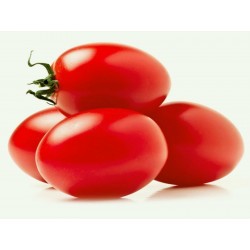Menu
-
MenuGeri
- Home
-
Kategoriler
-
-
Kategoriler
-
Sebze tohumları
-
Ülkelere Göre Çeşitler
- Ermenistan'dan çeşitler
- BH'den Çeşitler
- Hırvatistan'dan Çeşitler
- Fransa'dan Çeşitler
- Almanya'dan Çeşitler
- Yunanistan'dan Çeşitler
- Macaristan Çeşitleri
- Hindistan'dan Çeşitler
- İtalya'dan çeşitleri
- Japonya'dan Çeşitler
- Kuzey Makedonya çeşitleri
- Peru Çeşitleri
- Rusya'dan Çeşitler
- Sırbistan'dan Çeşitler
- Slovenya'dan Çeşitler
- İspanya Çeşitleri
- Tayland çeşitleri
- Türkiye'den Çeşitler
- ABD'den Çeşitler
- Domates tohumları
- Mısır tohumları
- Kabak ailesi
- Fasulye ailesi
- Salatalık tohumları
- Dolma biber tohumları
- Havuç ailesi
- Soğan ailesi
- Marul tohumları
- Patates ailesi
- Lahana ailesi
- Turp tohumları
- Pancar ailesi
- Karpuz tohumları
- Kavun tohumları
- Karnabahar tohumları
- Ayçiçeği ailesi
-
Ülkelere Göre Çeşitler
- Meyve tohumları
- Acı biber tohumları
- Tıbbi bitki tohumları
- Tırmanma bitki tohumları
- Ağaçlar - Çalı tohumları
- Palmiye tohumları
- Süs bitkileri tohumları
- Tütün tohumları
-
Sebze tohumları
-
-
-
-
- YENİ ÜRÜNLER
- Hesap oluştur
- Teslimat - Ödeme
- FAQ
- Ana Sayfa
-
- Büyük tohum paketleri
- Dev bitki tohumları
- Sebze tohumları
- Ülkelere Göre Çeşitler
- Ermenistan'dan çeşitler
- BH'den Çeşitler
- Hırvatistan'dan Çeşitler
- Fransa'dan Çeşitler
- Almanya'dan Çeşitler
- Yunanistan'dan Çeşitler
- Macaristan Çeşitleri
- Hindistan'dan Çeşitler
- İtalya'dan çeşitleri
- Japonya'dan Çeşitler
- Kuzey Makedonya çeşitleri
- Peru Çeşitleri
- Rusya'dan Çeşitler
- Sırbistan'dan Çeşitler
- Slovenya'dan Çeşitler
- İspanya Çeşitleri
- Tayland çeşitleri
- Türkiye'den Çeşitler
- ABD'den Çeşitler
- Domates tohumları
- Mısır tohumları
- Kabak ailesi
- Fasulye ailesi
- Salatalık tohumları
- Dolma biber tohumları
- Havuç ailesi
- Soğan ailesi
- Marul tohumları
- Patates ailesi
- Lahana ailesi
- Turp tohumları
- Pancar ailesi
- Karpuz tohumları
- Kavun tohumları
- Karnabahar tohumları
- Ayçiçeği ailesi
- Ülkelere Göre Çeşitler
- Meyve tohumları
- Acı biber tohumları
- Tıbbi bitki tohumları
- Tırmanma bitki tohumları
- Ağaçlar - Çalı tohumları
- Muz tohumları
- Palmiye tohumları
- Süs bitkileri tohumları
- Tütün tohumları
- Çiçek tohumları
- Kaktüs tohumları
- Su bitki tohumları
- Ekim Talimatları
- Meyve ve sebze şekil
- Mantar miselyumu
- Bitki soğanları
- Bambu tohumları
- Ayurveda Bitkileri
- F1 hibrit tohumları
- Ambalaj ve malzeme
- Cold-resistant plants
- Bitki bakımı
- Organik baharatlar
- Teslimat - Ödeme
- PayPal ve Kart ödemesi yok X
Last Product Reviews
Out of the two seeds, one germinated and the other one was dead and floatin...
By
 Riikka H on 07/03/2024
Riikka H on 07/03/2024
Verified Purchase
Çok satanlar
1308 adet ürün var.
Toplam 1308 üründen 1276-1290 arası gösteriliyor
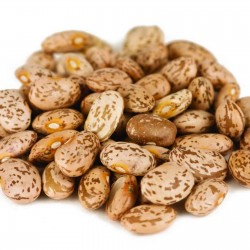
Pinto Bean Seeds (Phaseolus...
Fiyat
€2,00
(SKU: VE 141 (8g))
Seeds Gallery EU,
5/
5
<div id="idTab1" class="rte">
<h2 id="short_description_content"><strong>“Pinto” Bean Seeds (Phaseolus vulgaris)</strong></h2>
<h2 class=""><span style="color: #ff0000;"><strong>Price for Package of 20 seeds.</strong></span></h2>
<p>The pinto bean is a variety of common beans (Phaseolus vulgaris). It is the most common bean in the United States[1] and northwestern Mexico,[2] and is most often eaten whole in broth or mashed and refried. Either whole or mashed, it is a common filling for burritos. The young pods may also be harvested and cooked as green pinto beans.</p>
<p>In Spanish, they are called frijol pinto, literally "speckled bean", and in South America it is known as the "poroto frutilla", literally "strawberry bean". In Portuguese, they are called feijão carioca in Brazil (literally "carioca bean") and feijão catarino in Portugal. It is named for its mottled skin (compare pinto horse), hence it is a type of mottled bean.</p>
<p>This is the bean most commonly used for refried beans (fresh or canned) and in many dishes. Rice and pinto beans served with cornbread or corn tortillas are often a staple meal where meat is unavailable; the amino acids in this combination make it a complete protein source. This variety is often used in chili con carne, although the kidney bean, black bean, and many others may also be used in other locales.</p>
<p>Pinto beans are commonly eaten beans in Brazilian cuisine (legumes, mainly common bean, are a staple food everywhere in the country, cultivated since 3000 BCE, along with starch-rich foods, such as rice, manioc, pasta and other wheat-based products, polenta and other corn-based products, potatoes and yams).</p>
<p>In the southeastern part of the United States, pinto beans were once a staple of the people, especially during the winter months. Some churches in rural areas still sponsor "pinto bean suppers" for social gatherings and fund raisers.</p>
<p>The alubia pinta alavesa, or the "Alavese pinto bean", a red variety of the pinto bean, originated in Añana,[3] a town and municipality located in the province of Álava, in the Basque Country of northern Spain. In October, the Feria de la alubia pinta alavesa (Alavese pinto bean fair) is celebrated in Pobes.</p>
</div><script src="//cdn.public.n1ed.com/G3OMDFLT/widgets.js"></script>
VE 141 (8g)


Soğan tohumları Beyaz...
Fiyat
€1,95
(SKU: MHS 144)
Seeds Gallery EU,
5/
5
<h2><strong>Soğan tohumları Beyaz Lizbon (Allium cepa)</strong></h2>
<h2><span style="color: #ff0000;"><strong>250 (1 g) tohum paketi için fiyat.</strong></span></h2>
<p>Beyaz Lizbon, eski bir favori ve her zaman popüler olan çok hızlı büyüyen salata taze soğan. Parlak yeşil üstleri olan uzun beyaz gövdelere sahip dayanıklı ve güvenilir bir çeşittir. Büyümesi hızlı ve kolaydır, 60 gün içinde kırpılır. Mart ayından Eylül ayına kadar ardışık ekimler için geleneksel olarak en popüler Taze Soğan olmasına rağmen, sonbaharda ekilebilir ve erken ilkbahar hasatları için kışlanabilir. Konteyner yetiştirmek için mükemmeldir ve karışık konteynerlere veya yataklara sıkışabilir</p>
<p>Beyaz Lizbon, gümüş rengi cilt ve bu karakteristik 'ısırık' ile hafif bir soğan aromasına sahip gevrek, etli sapları ile iyi bir salata için vazgeçilmezdir. Gençken lezzetli, ampuller şişerken daha keskin bir lezzet alırlar. Çok az ekmek sık sık, iki haftada bir Mart ayından itibaren, yaz boyunca iyi bir tedarik sağlayacaktır.</p>
<p>Hazırlık:</p>
<p>İdeal bir pozisyon, önceki sonbaharda kazılmış ve gübrelenmiş iyi drenaja sahip açık, güneşli bir alan olacaktır. Taze gübre yatağına dikmeyin veya ekmeyin.</p>
<p>Önceki mahsulün soğan ailesinin olduğu bir alana dikim yapmaktan kaçının. Birçok katılımcı, doğurganlığı artırmak için gösteri soğanlarını kalıcı bir yatakta büyütür, ancak mutfak arsalarında, siteyi her yıl değiştirmek çok daha iyi bir fikirdir.</p>
<p>Soğanlar nötr ila hafif alkali toprağı tercih eder, bu nedenle toprak asitse kireç. Gerekirse genel bir gübre uygulayın ve toprak makul derecede kuruduğunda yüzeyi tırmıklayın. Bölgeyi açın ve daha sonra düzgün ve düzgün bir hava elde etmek için tekrar tırmıklayın.</p>
<p>Ekme:</p>
<p>Sonbaharda ekim yapın ya da kışın sonundan yaz sonuna kadar ekin.</p>
<p>Soğuk bölgelerde ve sergi ampulleri için Ocak ayında cam altında ekilir,</p>
<p>Dar veya geniş matkaplarda 12mm ()in) derinlikte ekim yapın, matkaplar arasında 15 ila 23 cm (6 ila 9 inç) izin verin. İnceltme gerekmez.</p>
<p>Tohum geniş bir sıcaklık aralığında çimlenir ve yüksek sıcaklıklarda daha hızlıdır. Sürekli ürünler için her 3 haftada bir ekin.</p>
<p>Yetiştirme:</p>
<p>Özellikle kuru hava büyüleri sırasında en kaliteli mahsuller için iyi sulanmış tutun. İyi sulanırsa uzun süre iyi duracaktır. Çapa dikkatlice veya elle yabancı ot - yoğun ot büyümesi verimi ciddi şekilde etkiler.</p>
<p>Hasat:</p>
<p>60 gün</p>
<p>Mayıs-Ekim ayları arasında gereken hasat, hava ılık kalması durumunda daha sonra ekimler Aralık ayına kadar kalabilir. Birkaç gün buzdolabında tutacak olsa da hemen kullanıldığında en iyisidir.</p>
<p>Mutfak Kullanımı:</p>
<p>Taze soğan, Pekin ördeği kreplerinize eklemekten çok daha fazlası için kullanılabilir. Çiğ veya çok hafif pişirildiklerinde, normal soğanların aşırı güç vereceği harika canlı ama hafif bir lezzet verir. Doğranmış taze soğanları kremalı patates püresine katlayarak biraz şampiyon yapın - isterseniz biraz rendelenmiş kaşar ekleyin - ve böyle basit bir yemeğin ne kadar fantastik tadabileceğini görün. Ya da bir dizi klasik Çin ve Japon yemeklerinin ruhunu oluşturmak için zencefil ile birleştirin.</p>
<p>Kökü ve yeşil tepelerden yaklaşık bir santimetre kesin. Ampul alanı çiğ veya pişmiş olarak yenebilir, ancak üstleri doğranmış ve servis yapmadan hemen önce bir tabağa eklenir.</p>
<p>Dört güne kadar buzdolabında saklayın.</p>
<p>Beslenme:</p>
<p>Yıllardır soğan, anti-bakteriyel, antiseptik ve anti-astmatik özellikleri için en eski ilaçlardan biri olarak kullanılmaktadır. Ayrıca kan basıncını ve kolesterol seviyelerini düşürdüğünü gösterdiler.</p>
<p>Zararlı Kovucu:</p>
<p>Allium ailesinin bir üyesi olarak, yaprak bitleri, sivrisinekler, havuç sinekleri ve domates zararlıları da dahil olmak üzere böceklerin çoğunu caydırmaya yardımcı olurlar. Onlar da, benler, fare salyangozları ve kurtlar ile mücadelede yararlıdır!</p>
<p>Dönme hususları:</p>
<p>Soğan, arpacık, sarımsak veya frenk soğanı izlemekten kaçının.</p>
<p>İyi Sahabeler:</p>
<p>Pancar, havuç, kereviz, maydanoz ve domates.</p>
<p>Kötü Yoldaşlar:</p>
<p>Yonca, fasulye, bezelye - Soğan baklagillerin büyümesini engeller.</p>
<p>Tarih:</p>
<p>Tarih öncesi çağlardan beri yenmiş ve yetiştirilmiş, eski Mısır'ın ilk hanedanında MÖ 3200 dolaylarında soğandan bahsedilmiş ve o zamandan beri mezar resimlerinde, yazıtlarında ve belgelerinde ortaya çıkmıştır. Bazı resimler, hem güçlü soğanları hem de soğanları ziyafet masalarına yığılmış soğanları tasvir ediyor.</p>
<p>Taze soğanın Uzak Doğu'dan geldiğine inanılmaktadır. Frenk soğanı ve taze soğan MÖ 2000 yılından itibaren Çin tarihinde kaydedilmiştir.</p>
<p>Eski Mısır'da büyüdüler ve sonunda Roma'ya geldiler ve Latince Unio kelimesinden soğan kelimesi olarak biliniyorlardı. Orta İngilizce'de, soğana dönüşen kelime geçtikçe bir birlik haline geldi.</p>
MHS 144 (250 S)

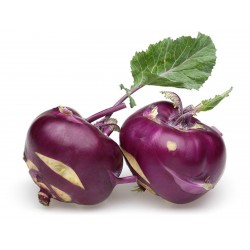
Alabaş tohumları Mor Viyana
Fiyat
€1,45
(SKU: VE 120 (1g))
Seeds Gallery EU,
5/
5
<h2><strong>Alabaş tohumları Mor Viyana</strong></h2>
<h2><span style="color:#ff0000;"><strong>250 (1 g) tohum paketi için fiyat.</strong></span></h2>
<p>Koyu mor kabuklu standart kolhrabi -alabaş- tohumudur. Geleneksel Kohlrabi tohumu olduklarından, yetiştireceğiniz bitkiden tohum alabilir ve aynı kalitede bitki takip eden sezon yetiştirebilirsiniz. En ideal hasat zamanı başların 6 cm çapa ulaştıkları zamandır. Genelde marketlerde göz doldurması için lezzetinden feragat edilerek daha büyük ve iri hale geldiklerinde hasat edilirler. Kohlrabi taze olarak pişirilmeden ya da pişirerek yemeklerde kullanabilirsiniz. Tohum ekiminden sadece 55 gün sonra ilk hasadı yapabilirsiniz. Hasat için doğru zaman başların orta boy bir elma büyüklüğüne geldiği, sulu ve körpe olduğu dönemdir. Depolanmaya da geldiğinden kış kullanımı için serin, don görmeyen havadar bir yerde saklayabilirsiniz.</p>
<p>Satışta olan tohumlar işlenmemiş, ilaçsız, geleneksel tohumlardır. Yetiştirdiğiniz meyvesinden tohum alabilirsiniz. Meyveden aldığınız tohumları oda sıcaklığında, nem, rutubet, ışık almayan serince bir çekmece içinde saklayınız.</p>
<p>Tohum ekimi</p>
<p>Kohlrabi - alabaş dikiminden önce toprağınızı hazırlayın. Kohlrabi, nem tutumu yüksek, geçirgen, tınlı kaliteli bahçe toprağı sever.</p>
<p>Tohumlar iç mekânda Nisan ayından itibaren, dış mekânda ise son donlardan sonra toprak ısınmaya başlayınca ekilir. İç mekânda erken fidelenen tohumlar, erken hasat almanızı sağlar.</p>
<p>Nasıl çimlendirilir ?</p>
<p>Kaliteli, nemli, havalandırılmış ekim toprağına tohumları 0,5 cm derine ekin. Sulayın. 17-22°C de tohumlar 6-10 günde hızla filizlenir. Tohumlar filizlenene dek toprak nemli tutulmalı ancak aşırı sulanmamalıdır. İç mekânda elle alınabilir duruma gelen filizler daha geniş saksılara alınarak dış mekâna dikilene kadar fidelenmelidir. Dış mekânda filizler, her yöne 30 cm aralık kalacak şeklide dikilmelidir. Sıralı dikimlerde her fide arası 30 her sıra arası 50 cm olmalıdır. Bundan sonra 14 günde bir sıvı gübre verilebilir. Tohumdan hasada ortalama 55 gün olup bu yapılacak bakım ve yetiştirme ortamına göre değişim gösterebilir.</p>
<p>Bakımı ve diğer bilgiler</p>
<p>Meyve boyu istediğiniz boya geldikçe toplamanız önerilir. Hasat için uygun boy başların orta boy bir elma büyüklüğüne eriştiği dönemdir. Meyvenin aşırı büyümesine izin vermeniz, bu meyveyi odunsu ve sert yaparak lezzetini kaybetmesine ve tohuma kaçmasına sebep olur. Sulamayı sabah erkenden yapmanız, daha sağlıklı gelişimine imkan sağlar.</p>
<p>Nerede yetiştirilir ?</p>
<p>Bahçe yetiştiriciliğine uygun.</p>
<p>Diğer</p>
<p>Bitki geleneksel tür olduğundan tohumu alınarak nesli devam ettirilebilir. Alınan tohumdan her yıl aynı kalitede bitki yetiştirebilirsiniz. Meyveden aldığınız tohumları oda sıcaklığında, nem, rutubet, ışık almayan serince bir çekmece içinde saklayınız. </p>
VE 120 (1g)

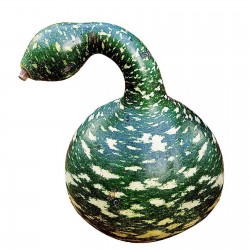
Gooseneck Kabak Tohumları
Fiyat
€2,75
(SKU: VG 55)
Seeds Gallery EU,
5/
5
<h2><strong>Gooseneck Kabak Tohumları</strong></h2>
<h2><span style="color: #ff0000;"><strong>5 adet tohumluk paket fiyatıdır.</strong></span></h2>
<p>Çok çekici sonbahar ve kış dekorasyonları. Bu balkabağına bayılacaksınız. Bu alışılmadık ve bulunması zor kabak, bir kaz andırıyor, dolayısıyla adı! Kalın şişe karınlı, ince boyunlu ve açık benekli koyu yeşil renkli geniş bir kafa. Çardakların, çitlerin ve kafeslerin hızla yeşillendirilmesi için uygundur. Tuhaf şekilli meyveler, dekorasyon ve el işleri için idealdir.</p>
<p>Çekici sonbahar ve kış dekorasyonları için güzel taze veya kurutulmuş</p>
<p>Cam altında ekim: Şubat - Nisan<br />Açık havada ekmek: Mayıs'tan itibaren<br />Dikim mesafesi: 40 cm x 60 cm<br />Ekim derinliği: 2 cm<br />Çimlenme periyodu: 20 - 25°C'de 6 - 15 gün</p>
VG 55 (5 S)


Soğuğa ve dona dayanıklı bitki

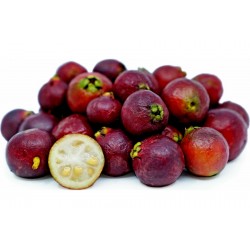
Strawberry Guava Seeds...
Fiyat
€3,25
(SKU: V 89)
Seeds Gallery EU,
5/
5
<!DOCTYPE html>
<html>
<head>
<meta http-equiv="Content-Type" content="text/html; charset=UTF-8" />
</head>
<body>
<h2><span style="text-decoration: underline;"><em><strong>Strawberry Guava Seeds , Cattley guava or Peruvian guava (Psidium cattleianum)</strong></em></span></h2>
<h3><span style="color: #ff0000;"><strong>Price for Package of 5 seeds.</strong></span></h3>
<p><span style="color: #000000;"><span style="font-family: Arial, sans-serif;"><span><strong>Fruit Description:</strong> Appearing in late Summer, they are small red fruit, very tasty, when ripe. Usually eaten fresh or used to flavor beverages, ice creams, desserts and jams. Strawberry guavas taste like a passionfruit mixed with strawberry. The skin is also edible and tastes a bit like rose petals but is best removed for a sweeter flavour. The seeds are small and white in colour and can be roasted as a substitute for coffee.</span></span></span></p>
<p><span style="color: #000000;"><span style="font-family: Arial, sans-serif;"><span><strong>Growth tips:</strong> Fast grower, fast to fruit, provide ample nutrition and water.</span></span></span></p>
<p><span style="color: #000000; font-family: Arial;"><strong>Usage</strong>: This plant is attractive to bees, butterflies and/or birds. Suitable for growing indoors</span></p>
<p xml:lang="en" lang="en" align="left"><span style="color: #000000;"><span style="font-family: Arial, sans-serif;"><span><strong>Aditional information: </strong>Psidium cattleianum is closely related to common guava (P. guajava), but can survive under lopwer temperatures. This plant is attractive to bees, butterflies and/or birds.</span></span></span></p>
<p xml:lang="en" lang="en" align="left"><strong><span style="color: #000000;"><span style="font-family: Arial, sans-serif;">Wikipedia:</span></span></strong></p>
<div>Psidium cattleianum,[1][2] named in honour of notable English horticulturist Sir William Cattley, commonly known as Cattley guava or Peruvian guava, is a small tree (2–6 m tall), bearing small red or yellow fruit, which are somewhat sour but sometimes eaten or made into jam. The red-fruited variety is known as strawberry guava; the yellow-fruited variety is known as lemon guava, and in Hawaii as waiawī. Native to Brazil and adjacent tropical South America, it is closely related to common guava (P. guajava), and like that species is a widespread, highly invasive species in tropical areas, especially Hawaiʻi. It tends to form dense, monotypic stands which prevent regrowth of native species, and is very difficult to eradicate; it also provides refuge for fruit flies which cause extensive agricultural damage.[3] As an invasive species, it is sometimes erroneously called Chinese guava.</div>
<p>The fruit can be eaten whole as both the thin skin and soft, juicy interior are edible. Strawberry guavas taste like a passionfruit mixed with strawberry; lemon guavas have a more acidic and spicier flavour. The skin is also edible and tastes a bit like rose petals but is often removed for a sweeter flavour. The seeds are small and white in colour and can be roasted as a substitute for coffee. Its leaves may be brewed for tea.</p>
<table style="width: 500px;" cellspacing="0" cellpadding="0" border="1">
<tbody>
<tr>
<td colspan="2" width="100%" valign="top">
<p align="center"><span style="color: #008000;"><strong>Sowing Instructions</strong></span></p>
</td>
</tr>
<tr>
<td valign="top" nowrap="nowrap">
<p align="center"><span style="color: #008000;"><strong>Propagation:</strong></span></p>
</td>
<td valign="top">
<p align="center"><span style="color: #008000;">Seeds</span></p>
</td>
</tr>
<tr>
<td valign="top" nowrap="nowrap">
<p align="center"><span style="color: #008000;"><strong>Pretreat:</strong></span></p>
</td>
<td valign="top">
<p align="center"><span style="color: #008000;">soak in water for 12-24 hours</span></p>
</td>
</tr>
<tr>
<td valign="top" nowrap="nowrap">
<p align="center"><span style="color: #008000;"><strong>Stratification:</strong></span></p>
</td>
<td valign="top">
<p align="center"><span style="color: #008000;">0</span></p>
</td>
</tr>
<tr>
<td valign="top" nowrap="nowrap">
<p align="center"><span style="color: #008000;"><strong>Sowing Time:</strong></span></p>
</td>
<td valign="top">
<p align="center"><span style="color: #008000;">all year round</span></p>
</td>
</tr>
<tr>
<td valign="top" nowrap="nowrap">
<p align="center"><span style="color: #008000;"><strong>Sowing Depth:</strong></span></p>
</td>
<td valign="top">
<p align="center"><span style="color: #008000;">0,5 cm</span></p>
</td>
</tr>
<tr>
<td valign="top" nowrap="nowrap">
<p align="center"><span style="color: #008000;"><strong>Sowing Mix:</strong></span></p>
</td>
<td valign="top">
<p align="center"><span style="color: #008000;">Coir or sowing mix + sand or perlite</span></p>
</td>
</tr>
<tr>
<td valign="top" nowrap="nowrap">
<p align="center"><span style="color: #008000;"><strong>Germination temperature:</strong></span></p>
</td>
<td valign="top">
<p align="center"><span style="color: #008000;">18-25°C</span></p>
</td>
</tr>
<tr>
<td valign="top" nowrap="nowrap">
<p align="center"><span style="color: #008000;"><strong>Location:</strong></span></p>
</td>
<td valign="top">
<p align="center"><span style="color: #008000;">bright + keep constantly moist not wet</span></p>
</td>
</tr>
<tr>
<td valign="top" nowrap="nowrap">
<p align="center"><span style="color: #008000;"><strong>Germination Time:</strong></span></p>
</td>
<td valign="top">
<p align="center"><span style="color: #008000;">10 - 45 days</span></p>
</td>
</tr>
<tr>
<td valign="top" nowrap="nowrap">
<p align="center"><span style="color: #008000;"><strong>Watering:</strong></span></p>
</td>
<td valign="top">
<p align="center"><span style="color: #008000;">Water regularly during the growing season</span></p>
</td>
</tr>
<tr>
<td valign="top" nowrap="nowrap"> </td>
<td valign="top">
<p align="center"><br /><span style="color: #008000;"> <em>Copyright © 2012 Seeds Gallery - Saatgut Galerie - Galerija semena. </em><em>All Rights Reserved.</em></span></p>
</td>
</tr>
</tbody>
</table>
</body>
</html>
V 89 R


Sırbistan'dan Çeşit

Soğuğa ve dona dayanıklı bitki
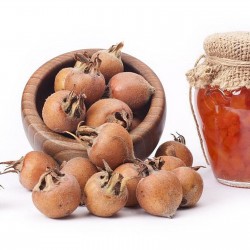
Muşmula ya da döngel...
Fiyat
€1,85
(SKU: V 92 (2.5g))
Seeds Gallery EU,
5/
5
<h2 class=""><strong>Muşmula ya da döngel tohumlar (Mespilus germanica)</strong></h2>
<h2><span style="color: #ff0000;"><strong>10 tohum paketi için fiyat.</strong></span></h2>
<p><strong>Muşmula</strong> ya da <strong>döngel</strong>, <strong>beşbıyık</strong>, <strong>ezgil</strong> (<em>Mespilus germanica</em>), gülgillerin bir altfamilyası olan Amygdaloideae'dan bir ağaç ve bu ağacın meyvelerdir.</p>
<p>Çiçek tablasıyla sarılmış etli meyveleri, eriksi yapıdadır. Yabani olanları daha küçük olur. İçinde sertleşmiş tohumları bulunur. Olgunlaştığında koyu kahverengiye dönen meyve kabuğu ve koyu kahve meyve eti vardır. İlk koparıldığında buruk bir tadı vardır. Bir süre beklenildiğinde yumuşar ve lezzetlenir. Karadeniz ve Marmara bölgelerinde yayılış gösterir.</p>
<p>Tam olgunlaşmadan yenmesi mümkün olmayan bu meyvenin olgunluk aşamasından sonra suda bekletilerek uzun süre dayanıklı kalması ve ballanarak yenmesi mümkündür.</p>
<p>Mespilus germanica 6 metre kadar büyüyebilir ancak genelde daha kısa ve çalı formunda kalır. Azami 50 yıl yaşar. Kabuk grimsi kahverengidir. Yapraklar koyu yeşil ve eliptik’tir. Yapraklar pubescenttir ve sonbaharda dökülmeden önce kırmızıya döner. Çiçekler geniş ovat ve beş petal’lidir. Çiçekler hermafrodit’tir. Meyveler 5 adet sert tohum barındırır. Tohumlar Kasım ayında olgunlaşır. Sıcak bir yaz ve çok sert olmayan bir kışın yaşandığı iklimi tercih eder. Güneş alan kuru yerleri ve hafif asitli toprakları sever. 50 yıl yaşayan örnekleri rapor edilmiştir. Mayıs ve Haziran aylarında çiçek açar.</p>
<p>Bitkileri kullanmadan önce mutlaka bir uzmandan yardım alın.</p>
<p>Olgunlaşmadan yenmemelidir. Böbrek kum ve taşlarının dökülmesine yardım eder. Bağırsakların iyi çalışmasını sağlar. İncebağırsak iltihabı, ishal ve dizanteriyi giderir. Kan dolaşımını düzenler. Sinirleri güçlendirir. Mide hastalıklarında faydalıdır. Aşırı tüketimi sindirim sistem’ine zararlıdır. Tohumlar toksik hidrosiyanik asit içerir ve fazla tüketilmemelidir. Astrenjan ve laksatiftir. Meyvenin pulpası laksatiftir. Tohumlar taşı dağıtıcı veya eriticidir.</p>
<p>Meyvesi yenilebilir. Hasat edildikten sonra ‘çürümeye’ bırakılır, meyvenin iç kısmı beyazdan kahverengiye döndüğünde yumuşak ve tropik meyveleri andıran lezzetli bir tada sahip olur.</p>
<p>Çalı formundaki bir bitki için oldukça geniş bir alana yayılır. Kökleri çok sağlamdır ve derine iner, bu nedenle onu yerinden sökmek kolay değildir. Cato’nun devrine kadar bu bitki İtalya’da mevcut değildi.</p>
<table cellspacing="0" cellpadding="0" border="1">
<tbody>
<tr>
<td colspan="2" width="100%" valign="top">
<p><span style="color: #008000;"><span style="font-family: 'Helvetica Neue', Helvetica, Arial, sans-serif;">Sowing Instructions</span></span></p>
</td>
</tr>
<tr>
<td valign="top" nowrap="nowrap">
<p><span style="color: #008000;"><span style="font-family: 'Helvetica Neue', Helvetica, Arial, sans-serif;">Propagation:</span></span></p>
</td>
<td valign="top">
<p><span style="color: #008000;"><span style="font-family: 'Helvetica Neue', Helvetica, Arial, sans-serif;">Seeds</span></span></p>
</td>
</tr>
<tr>
<td valign="top" nowrap="nowrap">
<p><span style="color: #008000;"><span style="font-family: 'Helvetica Neue', Helvetica, Arial, sans-serif;">Pretreat - Scarification:</span></span></p>
</td>
<td valign="top">
<p><span style="color: #008000;"><span style="font-family: 'Helvetica Neue', Helvetica, Arial, sans-serif;">Seeds previously with sandpaper roughen then kept in water for 24 hours.</span></span></p>
</td>
</tr>
<tr>
<td valign="top" nowrap="nowrap">
<p><span style="font-family: 'Helvetica Neue', Helvetica, Arial, sans-serif;"><span style="white-space: normal;"> </span></span></p>
<p><span style="color: #008000;"><span style="font-family: 'Helvetica Neue', Helvetica, Arial, sans-serif;">Stratification:</span></span></p>
</td>
<td valign="top">
<p><span style="color: #008000;"><span style="font-family: 'Helvetica Neue', Helvetica, Arial, sans-serif;">1. Keep Sowed seeds 2 weeks at room temperature (15-20 ˚ C).<br>2. Then let for 2 months in the refrigerator (at approximately 4 ˚ C).<br>3. After removing from the refrigerator, let in a very bright (no direct sunlight) and temperatures between 20 and 25 ˚ C.</span></span></p>
</td>
</tr>
<tr>
<td valign="top" nowrap="nowrap">
<p><span style="color: #008000;"><span style="font-family: 'Helvetica Neue', Helvetica, Arial, sans-serif;">Sowing Time:</span></span></p>
</td>
<td valign="top">
<p><span style="color: #008000;"><span style="font-family: 'Helvetica Neue', Helvetica, Arial, sans-serif;">all year round</span></span></p>
</td>
</tr>
<tr>
<td valign="top" nowrap="nowrap">
<p><span style="color: #008000;"><span style="font-family: 'Helvetica Neue', Helvetica, Arial, sans-serif;">Sowing Depth:</span></span></p>
</td>
<td valign="top">
<p><span style="color: #008000;"><span style="font-family: 'Helvetica Neue', Helvetica, Arial, sans-serif;">1-3mm / Requires light for germination.<br></span></span></p>
</td>
</tr>
<tr>
<td valign="top" nowrap="nowrap">
<p><span style="color: #008000;"><span style="font-family: 'Helvetica Neue', Helvetica, Arial, sans-serif;">Sowing Mix:</span></span></p>
</td>
<td valign="top">
<p><span style="color: #008000;"><span style="font-family: 'Helvetica Neue', Helvetica, Arial, sans-serif;">Coir or sowing mix + sand or perlite</span></span></p>
</td>
</tr>
<tr>
<td valign="top" nowrap="nowrap">
<p><span style="color: #008000;"><span style="font-family: 'Helvetica Neue', Helvetica, Arial, sans-serif;">Germination temperature:</span></span></p>
</td>
<td valign="top">
<p><span style="color: #008000;"><span style="font-family: 'Helvetica Neue', Helvetica, Arial, sans-serif;">20-25 ° C</span></span></p>
</td>
</tr>
<tr>
<td valign="top" nowrap="nowrap">
<p><span style="color: #008000;"><span style="font-family: 'Helvetica Neue', Helvetica, Arial, sans-serif;">Location:</span></span></p>
</td>
<td valign="top">
<p><span style="color: #008000;"><span style="font-family: 'Helvetica Neue', Helvetica, Arial, sans-serif;">bright + keep constantly moist not wet</span></span></p>
</td>
</tr>
<tr>
<td valign="top" nowrap="nowrap">
<p><span style="color: #008000;"><span style="font-family: 'Helvetica Neue', Helvetica, Arial, sans-serif;">Germination Time:</span></span></p>
</td>
<td valign="top">
<p><span style="color: #008000;"><span style="font-family: 'Helvetica Neue', Helvetica, Arial, sans-serif;">2-8 weeks - few Months.<br></span></span></p>
</td>
</tr>
<tr>
<td valign="top" nowrap="nowrap">
<p><span style="color: #008000;"><span style="font-family: 'Helvetica Neue', Helvetica, Arial, sans-serif;">Watering:</span></span></p>
</td>
<td valign="top">
<p><span style="color: #008000;"><span style="font-family: 'Helvetica Neue', Helvetica, Arial, sans-serif;">Water regularly during the growing season</span></span></p>
</td>
</tr>
<tr>
<td valign="top" nowrap="nowrap">
<p><span style="color: #008000;"><span style="font-family: 'Helvetica Neue', Helvetica, Arial, sans-serif;"> </span></span></p>
</td>
<td valign="top">
<p><span style="font-family: 'Helvetica Neue', Helvetica, Arial, sans-serif;"><br><span style="color: #008000;">Copyright © 2012 Seeds Gallery - Saatgut Galerie - Galerija semena. All Rights Reserved.</span></span></p>
</td>
</tr>
</tbody>
</table>
<script src="//cdn.public.n1ed.com/G3OMDFLT/widgets.js"></script>
V 92 (2.5g)


Tıbbi veya baharat bitkisi

Soğuğa ve dona dayanıklı bitki
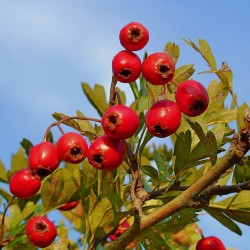
Kırmızı alıç tohumu...
Fiyat
€2,25
(SKU: T 43)
Seeds Gallery EU,
5/
5
<h2><strong>Kırmızı alıç tohumu (Crataegus)</strong></h2>
<h2><span style="color: #fe0000;"><strong>5 veya 10 adet tohumluk paket fiyatıdır.</strong></span></h2>
Kırmızı Alıç (Crataegus oxyacantha), saksıda 2-4 metre boylanabilen, dikenli, kırmızı çiçekli bir ağaçtır. Meyveleri 10-12 mm çapında, 1-3 tohumlu, kırmızı renklidir. Hafif ekşimsi, lezzetli meyveleri yenilmektedir.<br><br>Alıç ağacının yaprak, çiçek ve meyveleri Orta Çağdan beri özellikle kalp destekleyici ve kalp-damar sistemi fonksiyonlarını normalize etmek için kullanılmaktadır.<br><br>Alıç içerisindeki etken maddeler kalp kasları dejenerasyonunda ve koroner damarlardaki daralmalar sonucu gerekli miktarda kanın ve oksijenin kalp kaslarına gönderilememesi durumundaki oksijen yetersizliğine karşı da kalbin korunmasına yardımcı olmaktadır.<br><br>Yöresel olarak akdiken, yemişen, geviş, edran, geyik dikeni gibi isimlerle anılan alıç, tüketilmesi önerilen, insan sağlığı için en önemli bitkiler arasında yer alıyor.<br><br>Meyveleri olgunlaştığında kırmızı renk alan, yuvarlak görünümlü alıç, süs bitkisi olarak da kullanılır.<br><br>Kuzey Amerika, Asya, Avrupa ve Türkiye gibi kuzey yarımkürenin ılıman bölgelerinde yetişen alıcın 100'e yakın türü bulunur.<br><br>Alıç, Türkiye'de, derelere bakan yamaçlarda, kayalık, taşlık yerlerdeki çalılıklar içinde, ormanlarda ya da dağlık çevrelerde yetişir.<script src="//cdn.public.n1ed.com/G3OMDFLT/widgets.js"></script>
T 43 (10 S)

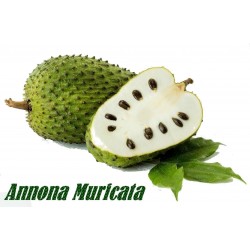
Graviola - Soursop Seeds...
Fiyat
€3,85
(SKU: V 10 AM)
Seeds Gallery EU,
5/
5
<h2><strong>Graviola - Soursop Seeds (Annona Muricata)</strong></h2>
<h2><span style="color:#ff0000;"><strong>Price for Package of 5 seeds.</strong></span></h2>
<p>Annona muricata, the Corossol or Soursop, is a tropical shrub from South America, Asia and Africa. This shrub will grow to a height of 4 to 6 meters high and 3 to 4 meters large. It gives delicious fruits. Annona muricata can even be grown in a pot.</p>
<p>Annona muricata has a cylindrical trunk. The foliage is made of shiny green oblong leaves. A sweet smell emerges from the leaves when they are crushed. The flowers are green-yellow and have a sweet smell. The plant produces green fruits are called soursops. They can weight up to 6 pounds and are covered with soft points. The flesh of the fruit is white and sweet-acidic. It is usually juiced instead of eaten and contains a lot of vitamins.</p>
<p>Annona blooms all year long in tropical regions. In milder climates, it blooms in spring and at the start of summer. It is a deciduous plant, which means that it loses its leaves when it rests. The plant will take 3 to 4 years before producing fruits.</p>
<p>Hardiness zones 10-11 (1°C/35°F,4°C/40°F) in winter. The plant dies when the temperature is below 0°C. Annonas need to be in a situation away from the wind. They are not rustic plants.</p>
<p>The plant thrives in full sun. Watering is done once a week and abundantly. Also, remember to cut the dead branches or the ones that are too low. Keep it far from the cold and the wind.</p>
<p><strong>The Annona can be grown in a pot.</strong></p>
<p><span style="color:#008000;"><strong>Additional Information</strong></span></p>
<table border="0" cellspacing="0" cellpadding="0"><tbody><tr><td>
<p><span style="color:#008000;"><strong>Germination</strong></span></p>
</td>
<td>
<p><span style="color:#008000;">Plant seeds in a good garden soil that is well-drained fertile soil. During growth, use a tutor. The tutor can even be used after growth. Fertilizer can be used once a week during growth. This plant enjoys a sunny spot. Germination takes 15-30 days, it can be longer, don’t get discouraged.</span></p>
</td>
</tr></tbody></table><p></p>
<p><strong>WIKIPEDIA:</strong></p>
<p>Annona muricata is a species of the genus Annona of the custard apple tree family, Annonaceae, known mostly for its edible fruit. The fruit is usually called soursop due to its slightly acidic taste when ripe. A. muricata is native to the Caribbean and Central America but is now widely cultivated – and in some areas, becoming invasive – in tropical climates throughout the world.</p>
<p><strong><em>Description</em></strong></p>
<p><strong>Habit</strong></p>
<p> Annona muricata is a small, upright, evergreen tree that can grow to about 4 metres (13 ft) tall.</p>
<p>Stems and leaves</p>
<p> The young branches are hairy.</p>
<p> Leaves are oblong to oval, 8 centimetres (3.1 in) to 16 centimetres (6.3 in) long and 3 centimetres (1.2 in) to 7 centimetres (2.8 in) wide. Glossy dark green with no hairs above, paler and minutely hairy to no hairs below.</p>
<p> The leaf stalks are 4 millimetres (0.16 in) to 13 millimetres (0.51 in) long and without hairs.</p>
<p><strong>Flowers</strong></p>
<p> Flower stalks (peduncles) are 2 millimetres (0.079 in) to 5 millimetres (0.20 in) long and woody. They appear opposite from the leaves or as an extra from near the leaf stalk, each with one or two flowers, occasionally a third.</p>
<p> Stalks for the individual flowers (pedicels) are stout and woody, minutely hairy to hairless and 15 millimetres (0.59 in) to 20 millimetres (0.79 in) with small bractlets nearer to the base which are densely hairy.</p>
<p> Petals are thick and yellowish. Outer petals meet at the edges without overlapping and are broadly ovate, 2.8 centimetres (1.1 in) to 3.3 centimetres (1.3 in) by 2.1 centimetres (0.83 in) to 2.5 centimetres (0.98 in), tapering to a point with a heart-shaped base. Evenly thick, covered with long, slender, soft hairs externally and matted finely with soft hairs within. Inner petals are oval-shaped and overlap. 2.5 centimetres (0.98 in) to 2.8 centimetres (1.1 in) by 2 centimetres (0.79 in). Sharply angled and tapering at the base. Margins are comparatively thin, with fine matted soft hairs on both sides. The receptacle is conical and hairy. Stamens 4.5 millimetres (0.18 in) long and narrowly wedge-shaped. The connective-tip terminate abruptly and anther hollows are unequal. Sepals are quite thick and do not overlap. Carpels are linear and basally growing from one base. The ovaries are covered with dense reddish-brown hairs, 1-ovuled, style short and stigma truncate.</p>
<p><strong>Fruits and reproduction</strong></p>
<p> Dark green, prickly (or bristled) fruits are egg-shaped and can be up to 30 centimetres (12 in) long, with a moderately firm texture. The flesh is juicy, acid, whitish and aromatic.</p>
<p> Abundant seeds[6] the average weight of 1000 fresh seeds is 470 grams (17 oz) and had an average oil content of 24%. When dried for 3 days in 60 °C (140 °F) the average seed weight was 322 grams (11.4 oz) and was tolerant of the moisture extraction; showing no problems for long-term storage under reasonable conditions.</p>
<p><strong>Medicinal use</strong></p>
<p>An extract from the leaves has been reportedly successful in lowering elevated blood pressure by its decreasing peripheral vascular resistance.</p>
<table border="1" cellspacing="0" cellpadding="0"><tbody><tr><td colspan="2" valign="top" width="100%">
<p><span style="color:#008000;"><strong>Sowing Instructions</strong></span></p>
</td>
</tr><tr><td valign="top" nowrap="nowrap">
<p><span style="color:#008000;"><strong>Propagation:</strong></span></p>
</td>
<td valign="top">
<p><span style="color:#008000;">Seeds / Cuttings</span></p>
</td>
</tr><tr><td valign="top" nowrap="nowrap">
<p><span style="color:#008000;"><strong>Pretreat:</strong></span></p>
</td>
<td valign="top">
<p><span style="color:#008000;">pour hot water over the seeds + soak about 24 h </span></p>
</td>
</tr><tr><td valign="top" nowrap="nowrap">
<p><span style="color:#008000;"><strong>Stratification:</strong></span></p>
</td>
<td valign="top">
<p><span style="color:#008000;">0</span></p>
</td>
</tr><tr><td valign="top" nowrap="nowrap">
<p><span style="color:#008000;"><strong>Sowing Time:</strong></span></p>
</td>
<td valign="top">
<p><span style="color:#008000;">all year round</span></p>
</td>
</tr><tr><td valign="top" nowrap="nowrap">
<p><span style="color:#008000;"><strong>Sowing Depth:</strong></span></p>
</td>
<td valign="top">
<p><span style="color:#008000;">1 cm</span></p>
</td>
</tr><tr><td valign="top" nowrap="nowrap">
<p><span style="color:#008000;"><strong>Sowing Mix:</strong></span></p>
</td>
<td valign="top">
<p><span style="color:#008000;">Coir or sowing mix + sand or perlite</span></p>
</td>
</tr><tr><td valign="top" nowrap="nowrap">
<p><span style="color:#008000;"><strong>Germination temperature:</strong></span></p>
</td>
<td valign="top">
<p><span style="color:#008000;">25 ° C +</span></p>
</td>
</tr><tr><td valign="top" nowrap="nowrap">
<p><span style="color:#008000;"><strong>Location:</strong></span></p>
</td>
<td valign="top">
<p><span style="color:#008000;">bright + keep constantly moist not wet</span></p>
</td>
</tr><tr><td valign="top" nowrap="nowrap">
<p><span style="color:#008000;"><strong>Germination Time:</strong></span></p>
</td>
<td valign="top">
<p><span style="color:#008000;">about 2-6 weeks</span></p>
</td>
</tr><tr><td valign="top" nowrap="nowrap">
<p><span style="color:#008000;"><strong>Watering:</strong></span></p>
</td>
<td valign="top">
<p><span style="color:#008000;">Water regularly during the growing season</span></p>
</td>
</tr><tr><td valign="top" nowrap="nowrap">
<p><span style="color:#008000;"><strong> </strong></span></p>
</td>
<td valign="top">
<p><br /><span style="color:#008000;">Seeds Gallery 05.11.2012.</span></p>
</td>
</tr></tbody></table>
V 10 AM (5 S)

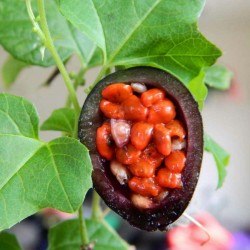
Blue Sweet Calabash Seeds...
Fiyat
€1,70
(SKU: V 18 PMC)
Seeds Gallery EU,
5/
5
<h2><span style="font-size:14pt;font-family:georgia, palatino, serif;"><strong>Blue Sweet Calabash Seeds (Passiflora morifolia)</strong></span></h2>
<h3><span style="color:#ff0000;font-size:14pt;font-family:georgia, palatino, serif;"><strong>Price for Package of 3 seeds.</strong></span></h3>
<div><span style="font-family:georgia, palatino, serif;">Passiflora morifolia (Blue sweet calabash or Woodland-Passion flower) is a white and purple flowered Passion flower with blue or purple fruit. The very fast-growing vine that can grow a few dozen feet in a season. Flowers are ornate, white, blue and purple fruits follow, which ripen to blue or purple. The orange pulp might be edible. The hardiness of P. morifolia is to at least 32 °F, some sources claim as low as 15-20 °F. It grows well in full sun or filtered sun. The vine is fast growing and once established it is quite vigorous. Its propagation is by seed or by cuttings. It is grown as an ornamental. It is not cultivated for its fruit. It is native to the parts of Central and South America.</span></div>
<div><span style="font-family:georgia, palatino, serif;"></span></div>
<div></div>
<table cellspacing="0" cellpadding="0" border="1"><tbody><tr><td colspan="2" width="100%" valign="top">
<p><span style="color:#008000;"><strong>Sowing Instructions</strong></span></p>
</td>
</tr><tr><td valign="top" nowrap="nowrap">
<p><span style="color:#008000;"><strong>Propagation:</strong></span></p>
</td>
<td valign="top">
<p><span style="color:#008000;">Seeds / Cuttings</span></p>
</td>
</tr><tr><td valign="top" nowrap="nowrap">
<p><span style="color:#008000;"><strong>Pretreat:</strong></span></p>
</td>
<td valign="top">
<p><span style="color:#008000;">about 24-48 hours soak in warm water</span></p>
</td>
</tr><tr><td valign="top" nowrap="nowrap">
<p><span style="color:#008000;"><strong>Stratification:</strong></span></p>
</td>
<td valign="top">
<p><span style="color:#008000;">0</span></p>
</td>
</tr><tr><td valign="top" nowrap="nowrap">
<p><span style="color:#008000;"><strong>Sowing Time:</strong></span></p>
</td>
<td valign="top">
<p><span style="color:#008000;">all year round</span></p>
</td>
</tr><tr><td valign="top" nowrap="nowrap">
<p><span style="color:#008000;"><strong>Sowing Depth:</strong></span></p>
</td>
<td valign="top">
<p><span style="color:#008000;">0.5 cm</span></p>
</td>
</tr><tr><td valign="top" nowrap="nowrap">
<p><span style="color:#008000;"><strong>Sowing Mix:</strong></span></p>
</td>
<td valign="top">
<p><span style="color:#008000;">Coir or sowing mix + sand or perlite</span></p>
</td>
</tr><tr><td valign="top" nowrap="nowrap">
<p><span style="color:#008000;"><strong>Germination temperature:</strong></span></p>
</td>
<td valign="top">
<p><span style="color:#008000;">25 ° C +</span></p>
</td>
</tr><tr><td valign="top" nowrap="nowrap">
<p><span style="color:#008000;"><strong>Location:</strong></span></p>
</td>
<td valign="top">
<p><span style="color:#008000;">bright + keep constantly moist not wet</span></p>
</td>
</tr><tr><td valign="top" nowrap="nowrap">
<p><span style="color:#008000;"><strong>Germination Time:</strong></span></p>
</td>
<td valign="top">
<p><span style="color:#008000;">2-4 Weeks</span></p>
</td>
</tr><tr><td valign="top" nowrap="nowrap">
<p><span style="color:#008000;"><strong>Watering:</strong></span></p>
</td>
<td valign="top">
<p><span style="color:#008000;">Water regularly during the growing season</span></p>
</td>
</tr><tr><td valign="top" nowrap="nowrap">
<p><span style="color:#008000;"><strong> </strong></span></p>
</td>
<td valign="top">
<p><br /><span style="color:#008000;"><em>Copyright © 2012 Seeds Gallery - Saatgut Galerie - Galerija semena. All Rights Reserved.</em></span></p>
</td>
</tr></tbody></table>
V 18 PMC (3 S)

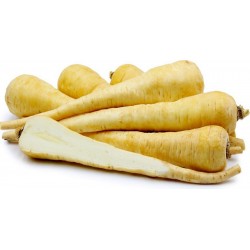
10.000 Seeds Long White...
Fiyat
€10,00
(SKU: P 123 (20g))
Seeds Gallery EU,
5/
5
<h2><strong>10.000 Seeds Long White Smooth Parsnip</strong></h2>
<h2><span style="color:#ff0000;"><strong>Price for Package about 10,000 (20 g) seeds.</strong></span></h2>
<div>One of the most popular and reliable varieties, producing Long rooted and broad shouldered roots making it suitable for almost all soil types. A high yielder, it has good canker resistance and will deliver lots of fine, medium length, smooth skinned, high quality, fine flavoured parsnips.</div>
<table cellspacing="0" cellpadding="0" border="1"><tbody><tr><td colspan="2" width="100%" valign="top">
<p><span style="color:#008000;"><strong>Sowing Instructions</strong></span></p>
</td>
</tr><tr><td valign="top" nowrap="nowrap">
<p><span style="color:#008000;"><strong>Propagation:</strong></span></p>
</td>
<td valign="top">
<p><span style="color:#008000;">Seeds</span></p>
</td>
</tr><tr><td valign="top" nowrap="nowrap">
<p><span style="color:#008000;"><strong>Pretreat:</strong></span></p>
</td>
<td valign="top">
<p><span style="color:#008000;">0</span></p>
</td>
</tr><tr><td valign="top" nowrap="nowrap">
<p><span style="color:#008000;"><strong>Stratification:</strong></span></p>
</td>
<td valign="top">
<p><span style="color:#008000;">0</span></p>
</td>
</tr><tr><td valign="top" nowrap="nowrap">
<p><span style="color:#008000;"><strong>Sowing Time:</strong></span></p>
</td>
<td valign="top">
<p><span style="color:#008000;">all year round </span></p>
</td>
</tr><tr><td valign="top" nowrap="nowrap">
<p><span style="color:#008000;"><strong>Sowing Depth:</strong></span></p>
</td>
<td valign="top">
<p><span style="color:#008000;">3 cm</span></p>
</td>
</tr><tr><td valign="top" nowrap="nowrap">
<p><span style="color:#008000;"><strong>Sowing Mix:</strong></span></p>
</td>
<td valign="top">
<p><span style="color:#008000;">Coir or sowing mix + sand or perlite</span></p>
</td>
</tr><tr><td valign="top" nowrap="nowrap">
<p><span style="color:#008000;"><strong>Germination temperature:</strong></span></p>
</td>
<td valign="top">
<p><span style="color:#008000;">15-25 ° C</span></p>
</td>
</tr><tr><td valign="top" nowrap="nowrap">
<p><span style="color:#008000;"><strong>Location:</strong></span></p>
</td>
<td valign="top">
<p><span style="color:#008000;">bright + keep constantly moist not wet</span></p>
</td>
</tr><tr><td valign="top" nowrap="nowrap">
<p><span style="color:#008000;"><strong>Germination Time:</strong></span></p>
</td>
<td valign="top">
<p><span style="color:#008000;">up to 3 weeks</span></p>
</td>
</tr><tr><td valign="top" nowrap="nowrap">
<p><span style="color:#008000;"><strong>Watering:</strong></span></p>
</td>
<td valign="top">
<p><span style="color:#008000;">Water regularly during the growing season</span></p>
</td>
</tr><tr><td valign="top" nowrap="nowrap">
<p><span style="color:#008000;"><strong> </strong></span></p>
</td>
<td valign="top">
<p><br /><span style="color:#008000;"><em>Copyright © 2012 Seeds Gallery - Saatgut Galerie - Galerija semena. </em><em>All Rights Reserved.</em></span></p>
</td>
</tr></tbody></table>
P 123 (20g)

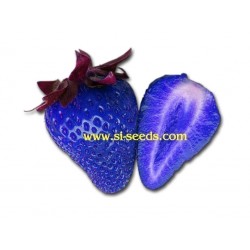
African Blue Strawberries...
Fiyat
€4,50
(SKU: V 1 B)
Seeds Gallery EU,
5/
5
<h2><strong>AFRICAN BLUE STRAWBERRIES SEEDS</strong></h2>
<h2><strong><span style="color:#ff0000;">Price for Package of 5 seeds.</span></strong></h2>
<p>Scientists are genetically modifying strawberries in order to allow them to resist freezing temperatures better. They're doing it by artificial transfer of genes from a species of fish called the Arctic Flounder Fish. The Arctic Flounder Fish produces an anti-freeze that allows it to protect himself in freezing waters.<br /><br />They isolated the gene that produces this anti-freeze and introduced it to the strawberry. The result is a strawberry that looks blue and doesn't turn to mush or degrade after being placed in the freezer. While they're not in production, research is ongoing.</p>
<p><strong><a href="http://buzz.naturalnews.com/000061-food-science-GMO.html" target="_blank" rel="noreferrer noopener">http://buzz.naturalnews.com/000061-food-science-GMO.html</a></strong></p>
V 1 B

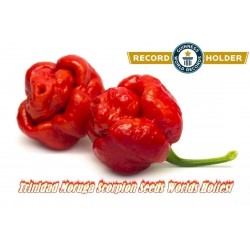
Trinidad Moruga Scorpion...
Fiyat
€1,95
(SKU: C 1 R)
Seeds Gallery EU,
5/
5
<h2><strong>Trinidad Moruga Scorpion Seeds Worlds Hottest</strong></h2>
<h2><strong><span style="color:#ff0000;">Price for Package of 5, 10, 25 seeds.</span> </strong></h2>
<p><strong>As you can see yourself from our photos, that the seeds are from our own plants (organically grown) and you know what you will get from the seeds you buy from us...</strong></p>
<p>The Trinidad Moruga Scorpion (Capsicum Chinense), endemic to the district of Moruga in Trinidad and Tobago, is currently the world's hottest Chili pepper cultivar. The New Mexico State University's Chili Pepper Institute has identified the Trinidad Moruga Scorpion as the newest hottest chili pepper in the world as of February 2012. According to the New Mexico State University Chili Institute, the Trinidad Moruga Scorpion ranks as high as 2,009,231 SHU on the Scoville scale, making it the hottest chili pepper in the world to date.</p>
<p>Paul Bosland, a renowned chili pepper expert and director of the Chili Institute, said, "You take a bite. It doesn't seem so bad, and then it builds and it builds and it builds. So it is quite intense."</p>
<p>The golf ball-sized chili pepper scored the highest among a handful of chili cultivars reputed to be among the hottest in the world. Its mean heat topped more than 1.2 million units on the Scoville heat scale, while fruits from some individual plants reached 2 million heat units.</p>
<p>Leaving out the heat the Moruga Scorpion has a tender fruitlike flavor, which makes it a unique sweet-hot combination.</p>
<div><em><strong> Video:</strong></em> <span style="color:#0000ff;"><a href="http://www.youtube.com/watch?v=P2iWb6a8QD4" target="_blank" rel="noreferrer noopener"><span style="color:#0000ff;">http://www.youtube.com/watch?v=P2iWb6a8QD4</span></a></span></div>
<h3>Scoville ratings of peppers </h3>
<h3><strong><span style="color:#0000ff;"><a href="http://en.wikipedia.org/wiki/Trinidad_Moruga_Scorpion" target="_blank" rel="noreferrer noopener"><span style="color:#0000ff;">http://en.wikipedia.org/wiki/Trinidad_Moruga_Scorpion</span></a></span></strong></h3>
C 1 R

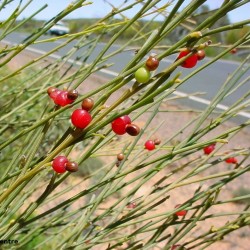
Weeping Cherry Seeds...
Fiyat
€1,35
(SKU: V 61)
Seeds Gallery EU,
5/
5
<meta http-equiv="Content-Type" content="text/html; charset=UTF-8" />
<h2><strong>Weeping Cherry Seeds (Exocarpos sparteus)</strong></h2>
<h2><span style="color: #ff0000;"><strong>Package of 2 seeds.</strong></span></h2>
<div>Exocarpos sparteus is an Australian endemic plant species, commonly known as the Broom Ballart or native cherry. The species is found in all states of mainland Australia.</div>
<div>A shrub, four metres tall, erect, with drooping branchlets, almost leafless. The species bears flowering branchlets, which may have small, greenish-yellow, and stalkless leaves. The flowers are just 1 mm across and of a similar colour, occasionally white. The fruit of this species is egg-shaped, pink or red, and between 4 and 5 mm long.</div>
<div>The habit of this plant is upright, becoming slightly curved, combining with the many regular branches to form a rounded aspect. The smooth and spherical appearance of the species is given by the droop of the branchlets, the similar colour and size of the leaves and flowers, and upcurving of the outward branches.</div>
<div>The specific name is derived from the Latin word esparto, referring to a kind of Spanish grass that was used for its fibre. It was first described by Robert Brown, in 1810, having collected the plants on his visit to King George Sound in 1802. One of the species' common names, Native Cherry, is given to another cogenor with an edible fruit, Exocarpos cupressiformis; both of these species are known as sorts of Ballart.</div>
<div>A shrub, four metres tall, erect, with drooping branches.</div>
<div>The fruit is egg-shaped, pink or red.</div>
<div>The tree look similar to a small cypress tree, but it has sweet, juicy fruits which are eaten fresh.</div>
<div>The sap was used by the Aboriginals as a treatment for snake bites.</div>
<table border="1" cellspacing="0" cellpadding="0">
<tbody>
<tr>
<td colspan="2" valign="top" width="100%">
<p><span style="color: #008000;"><strong>Sowing Instructions</strong></span></p>
</td>
</tr>
<tr>
<td valign="top" nowrap="nowrap">
<p><span style="color: #008000;"><strong>Propagation:</strong></span></p>
</td>
<td valign="top">
<p><span style="color: #008000;">Seeds</span></p>
</td>
</tr>
<tr>
<td valign="top" nowrap="nowrap">
<p><span style="color: #008000;"><strong>Pretreat:</strong></span></p>
</td>
<td valign="top">
<p><span style="color: #008000;">soak in water for 24 hours</span></p>
</td>
</tr>
<tr>
<td valign="top" nowrap="nowrap">
<p><span style="color: #008000;"><strong>Stratification:</strong></span></p>
</td>
<td valign="top">
<p><span style="color: #008000;">3 months in moist sowing mix at 2-5 ° C refrigerator</span></p>
</td>
</tr>
<tr>
<td valign="top" nowrap="nowrap">
<p><span style="color: #008000;"><strong>Sowing Time:</strong></span></p>
</td>
<td valign="top">
<p><span style="color: #008000;">all year round</span></p>
</td>
</tr>
<tr>
<td valign="top" nowrap="nowrap">
<p><span style="color: #008000;"><strong>Sowing Depth:</strong></span></p>
</td>
<td valign="top">
<p><span style="color: #008000;">0,5-1 cm</span></p>
</td>
</tr>
<tr>
<td valign="top" nowrap="nowrap">
<p><span style="color: #008000;"><strong>Sowing Mix:</strong></span></p>
</td>
<td valign="top">
<p><span style="color: #008000;">Coir or sowing mix + sand or perlite</span></p>
</td>
</tr>
<tr>
<td valign="top" nowrap="nowrap">
<p><span style="color: #008000;"><strong>Germination temperature:</strong></span></p>
</td>
<td valign="top">
<p><span style="color: #008000;">min. 20 ° C</span></p>
</td>
</tr>
<tr>
<td valign="top" nowrap="nowrap">
<p><span style="color: #008000;"><strong>Location:</strong></span></p>
</td>
<td valign="top">
<p><span style="color: #008000;">bright + keep constantly moist not wet</span></p>
</td>
</tr>
<tr>
<td valign="top" nowrap="nowrap">
<p><span style="color: #008000;"><strong>Germination Time:</strong></span></p>
</td>
<td valign="top">
<p><span style="color: #008000;">until it germinates </span></p>
</td>
</tr>
<tr>
<td valign="top" nowrap="nowrap">
<p><span style="color: #008000;"><strong>Watering:</strong></span></p>
</td>
<td valign="top">
<p><span style="color: #008000;">Water regularly during the growing season</span></p>
</td>
</tr>
<tr>
<td valign="top" nowrap="nowrap">
<p><span style="color: #008000;"><strong> </strong></span></p>
</td>
<td valign="top">
<p><br /><span style="color: #008000;"><em>Copyright © 2012 Seeds Gallery - Saatgut Galerie - Galerija semena. </em><em>All Rights Reserved.</em></span></p>
</td>
</tr>
</tbody>
</table>
V 61 (2 S)

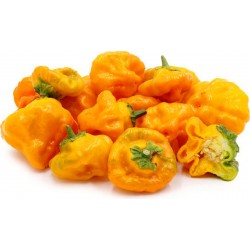
Jamaican Hot Yellow Chili...
Fiyat
€2,05
(SKU: C 35)
Seeds Gallery EU,
5/
5
<h2><strong>Jamaican Hot Yellow Chili Seeds</strong></h2>
<h2><span style="color:#ff0000;"><strong>Price for Package of 5 seeds.</strong></span></h2>
<p>Scotch Bonnet peppers (or Bahamian, Bahama Mama, Jamaican Hot or Martinique Peppers) are EXTREMELY HOT and closely related to the Habanero but less common. The flavor is slightly different, which some people prefer. Like the Habanero, Scotch Bonnets are spherical, although more squashed in shape and smaller. </p>
<p>Native to the Caribbean, Scotch Bonnet Peppers can be found in green, yellow, orange, white, brown and red as well as multi-toned. This is the YELLOW variety which is even more difficult to find than the red variety and other varieties.</p>
<p><strong><strong>see also our video:</strong></strong></p>
<div>
<div><span style="color:#0000ff;"><strong><a href="http://www.youtube.com/watch/?v=HxtWF_w9UDo&feature=plcp" target="_blank" rel="noreferrer noopener"><span style="color:#0000ff;">http://www.youtube.com/watch?v=HxtWF_w9UDo&feature=plcp</span></a></strong></span></div>
</div>
<div> </div>
<div>
<div><strong>Video 2:</strong></div>
</div>
<div><span style="color:#0000ff;"><strong><a href="http://www.youtube.com/watch/?v=viwzADvNyzQ&feature=plcp" target="_blank" rel="noreferrer noopener"><span style="color:#0000ff;">http://www.youtube.com/watch?v=viwzADvNyzQ&feature=plcp</span></a></strong></span></div>
C 35






